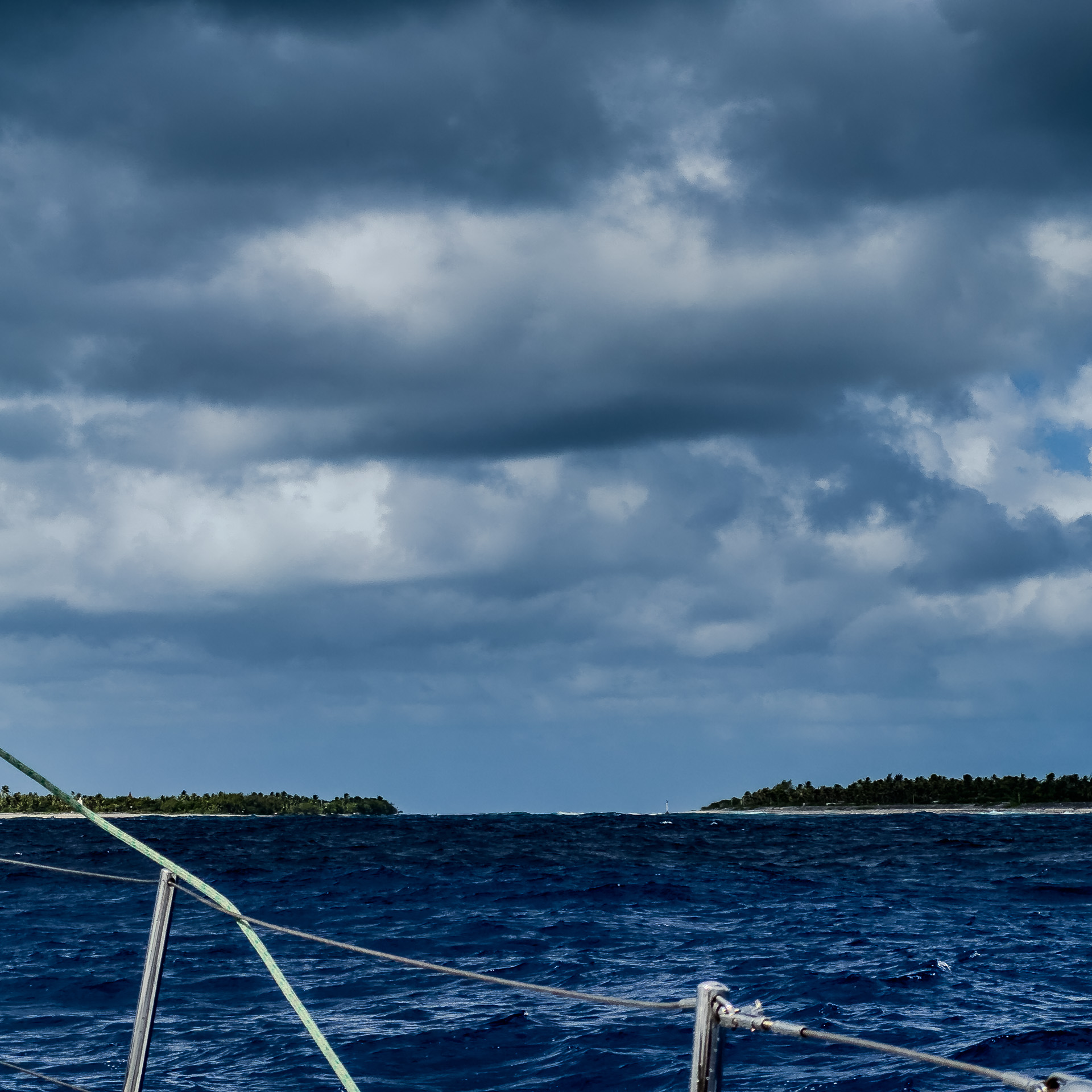I’d sailed the Tuamotus before—two weeks in Kauehi, which I loved for its quiet simplicity, and ten days in the southern part of Fakarava’s lagoon. That was in 2023, when my ninety-day visa in French Polynesia forced me to keep moving. I’d wanted to see Rangiroa then but ran out of time. What stayed with me wasn’t one particular island, but the Tuamotus themselves—their silence, their endless blues, and the feeling of being far from anything that demands urgency.
When Jane and I later secured long-stay visas and made the upwind passage from New Zealand, we weren’t chasing a single destination. We simply wanted to spend more time in this scattered chain of atolls—to explore the lesser-known motus, the quiet corners we’d missed the first time. Rangiroa seemed a natural beginning: close enough to Tahiti for an easy sail, large enough to provision and stage before heading east and south through the group, and long on reputation. I wanted to see what I’d skipped.
We left Tahiti after a week at Marina Taina—rested, reprovisioned, and ready to be at sea again. The trades were light, the sea calm. It wasn’t a difficult passage, just a steady run north and east, the kind that reminds you how simple sailing can be when the boat finds her rhythm.
From sea level, atolls appear only at the last moment—thin, uncertain lines that waver in and out of sight until you’re almost upon them. On our approach from the west-southwest, Rangiroa first looked like a trick of light: the sea rippling oddly, a faint green smudge that could have been imagination. Then the haze lifted, and the shape held—palm trees, a line of surf, the shimmer of white water against the reef. The second-largest atoll in the world, Rangiroa revealed itself slowly, as most worthwhile things do.
We skirted the atoll’s northwestern tip, following the reef southeast toward Tiputa Pass, but the sun slipped away too fast. I never enter a new anchorage after dark, so we hove to offshore for the night. Wanderlust drifted quietly, the sea breathing beneath her hull, the sound of the reef carrying softly across the dark.
At first light, with the ebb almost at slack, we entered Tiputa Pass, sailed around Motu Nuhi Nuhi, and anchored off the Kia Ora Resort. March and April are the busy months in French Polynesia—boats arriving from Panama and the U.S. west coast after their Pacific crossings. Several yachts from the World ARC fleet and others on the Coconut Milk Run were already here, anchored close together off the resort. The lagoon was alive with wakes and music, more movement than the Tuamotus usually offer, but even in the bustle it was easy to see why sailors stop here. We stayed three weeks, taking a short sail to the Blue Lagoon for a few days before returning so one of our crew could see a doctor for an ear infection. Once she’d recovered, we moved on—to Kauehi, then Tahanea—each more remote and peaceful than the last.
Later, after exploring Moorea, Raiatea, and Taha’a, we would come back to Rangiroa again, this time in its quieter season and at its truest pace. But that’s part of what the Tuamotus do: they draw you back, revealing themselves only when you take the time to stay.
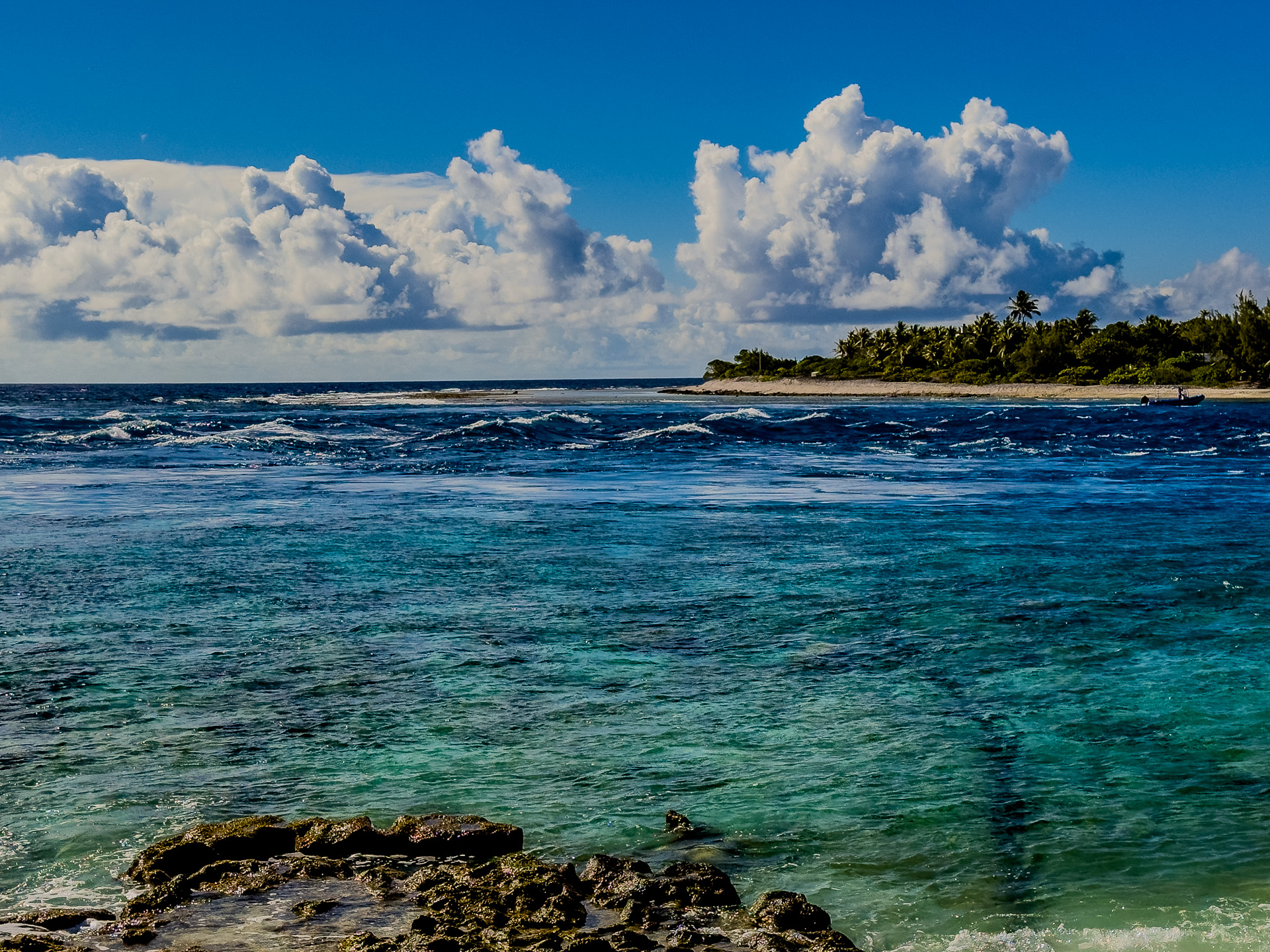
ENTERING THE LAGOON
Pass entrances in the Tuamotus always deserve respect. Peak tidal currents average four knots, and seven or eight isn’t unusual. The charts and tide tables help, but they’re only guides. Wind direction, swell, and how much water the lagoon has been holding can shift the timing by an hour or more. I like to arrive early, hold off until the surface begins to smooth, and then line up when the flow looks manageable.
Whenever possible, I sail through. There’s a certain satisfaction in doing it under sail—feeling the boat’s momentum and the wind’s power carry her forward. Still, I keep the engine idling in neutral, ready if things don’t go as planned. I misjudged once at another atoll where the tide tables promised only a light current. The pass looked calm, but once inside there was a six-knot adverse current pushing Wanderlust sideways toward the reef. It never felt dangerous—we could have turned back easily—but I advanced the throttle and let the 110-horsepower Yanmar add the speed we needed to power through the hundred meters of the worst of it. A minute later, we were clear and sailing again.
Crossing the line between ocean and lagoon never feels routine. The water changes color and texture; the motion shifts from roll to glide. The surf fades behind you, replaced by the quieter sounds of wind and rigging. No matter how many times I do it, there’s always a quiet satisfaction when we’re through—an acknowledgment of the seamanship it takes, and of the ocean’s permission to enter.
Tiputa Pass at Rangiroa is one of the easier ones. It’s wide, and the entry is usually downwind, which takes some pressure off. Because Wanderlust draws six feet nine inches, I play it safe and favor the deeper left-hand channel around Motu Nuhi Nuhi.
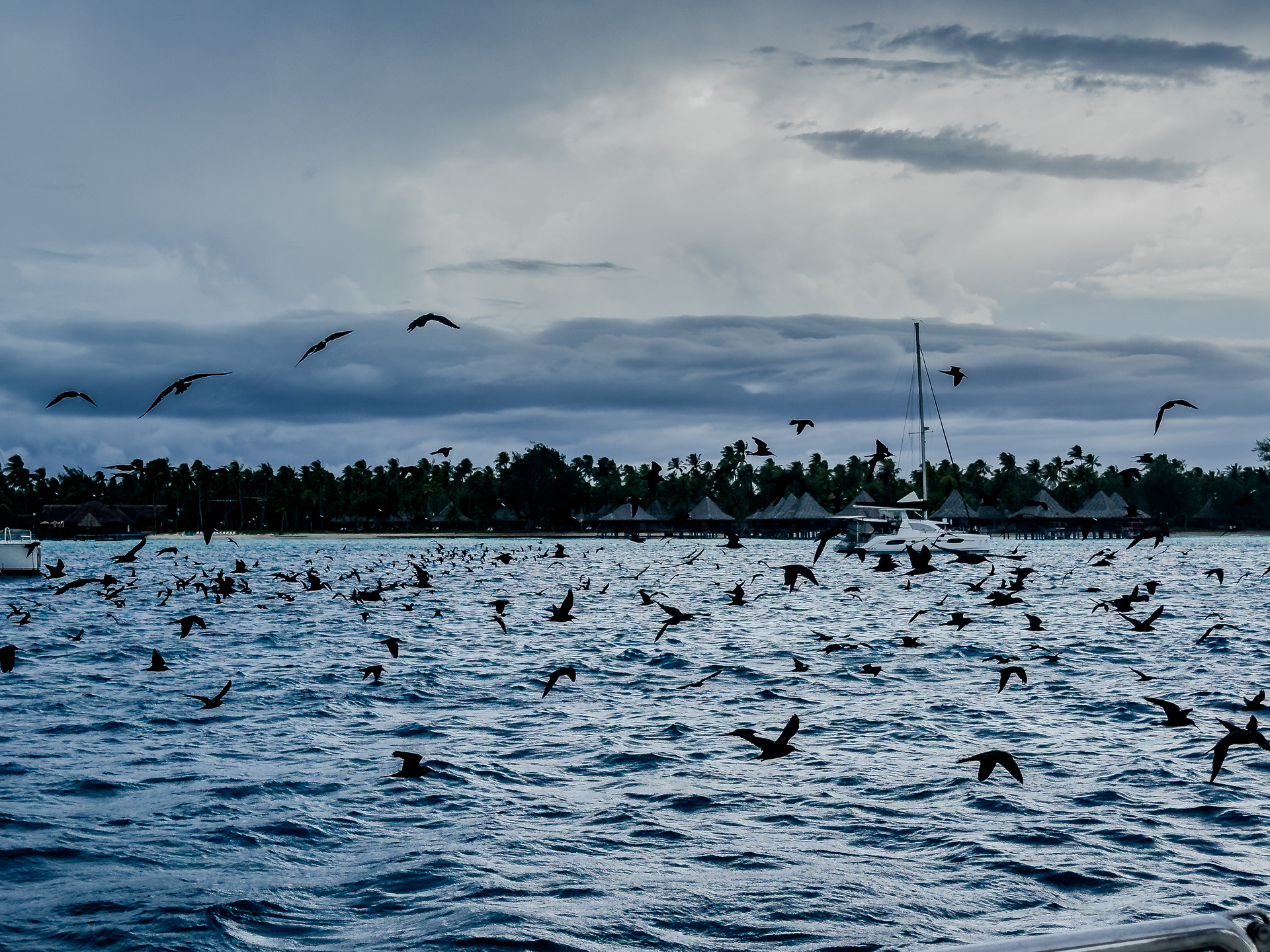
THE RHYTHM OF DAYS
Most sailors stop in Rangiroa for only a few days—just long enough to dive the pass or restock before pushing on, either to the Societies or another atoll along their route. Many, especially those in the ARC, are crossing the entire South Pacific in one season. From the start, we knew we’d stay longer. There’s something about the place that asks you to linger. It’s remote yet easy, connected but still wild. The people are friendly, the anchorage comfortable, and there’s just enough infrastructure to make life smooth without dulling its edges.
Days here fall into their own rhythm. Mornings begin softly. The light creeps in pale and low, touching the lagoon before it reaches the cockpit. Coffee brews while the air is still cool. Fish ripple the surface, and brown noddies wheel overhead, diving and chattering as they feed.
Jane described it better than I ever could in something she wrote one morning at anchor:
“Morning light slips into the berth, followed by cotton-candy pinks. Soon, the night’s deep navy cedes to azure. The day begins. Wind and current decide the water’s mood—playful rocking, ferocious rolling, or gentle bobbing. The choice is out of your hands. Yet the waves provide a metaphor for change—letting go of what no longer serves, bringing wants and needs into sharper focus.”
Her words capture what the Tuamotus do to your sense of time—they stretch it. Out here, the line between doing and being fades. We read, write, tinker with the boat. Sometimes we swim off the stern or drift in the dinghy to watch the fish. Some days we don’t do much at all—and those days are often the best ones.
On our second visit, the transient fleet had moved on. The lagoon was calm again, the anchorage nearly empty. That’s when Rangiroa revealed itself to us—the easy rhythm of life ashore, the quiet anchorages, the feeling that we could stay as long as we wished. What had been a convenient first stop became a place we wanted to return to, a reminder that some destinations earn their meaning only after you come back.
When the wind shifts southeast, the long fetch of the lagoon allows the waves to build, and the anchorage begins to roll. At night the motion rocks you to sleep, the hull tapping gently against the sea. It’s never unpleasant—just part of the rhythm.

PEOPLE AND CONNECTIONS
Though small, Rangiroa is far from empty. Flights arrive daily from Tahiti, bringing visitors to a handful of resorts and pensions, yet the atoll retains its Polynesian heart. The French influence shows in the language and bits of the cuisine, but the rhythm of life remains deeply local—families living along the motus, fishing, and greeting travelers with a sincerity that feels unhurried and unforced. Like I did in the Caribbean, we’ve adopted the local custom of greeting everyone we pass with a friendly “Ia Ora Na” or simply “’rana,” a small exchange that says as much about island warmth as any long conversation.
Over time, we’ve come to know a few of the people who give this place its warmth. The family that runs Rangiroa Shuttle has become our link to shore life. A quick WhatsApp message and they appear at the pier, smiling, always in good spirits. The driver often has a child or a relative along for the ride, and the conversation flows easily—weather, family, fishing, the state of the reef, how the wind has been behaving. They wait while we stop at the ATM, the pharmacy, or the grocery store, waving at friends who pass by on scooters. It’s an ordinary exchange by local standards but one that feels personal, woven into the rhythm of our days here.
The atoll’s small pharmacy and clinic sit side by side, and like much of life in Rangiroa, they work on trust and simplicity. When I needed a refill for a prescription, the doctor listened, nodded, and wrote it on the spot—no paperwork, no appointment, just a handshake and a smile. There’s a practicality to island life that you can’t help but appreciate.
The same spirit runs through the small craft tables near the commercial wharf, where local women sell shells, woven goods, and jewelry. We stop to talk most times we come ashore, learning bits and pieces about families, fishing, and the steady changes brought by tourism. We’ve bought a few small things over time, but what stays with us isn’t the transaction—it’s the conversation, the laughter, the easy warmth.
Even at the resort, the connection feels genuine. The staff in the restaurant and bar recognize us now and ask about our boat or where we’re headed next. There’s always time to talk; no one rushes the moment. When we haven’t been ashore in a while, it’s nice to sit on the terrace in the late afternoon, watching the light slide across the lagoon. The setting is beautiful, yes, but it’s the people who make it feel like somewhere worth belonging to, if only for a while.
What keeps us coming back to Rangiroa isn’t just the clear water or the famous diving. It’s the people who live here—their calm humor, their steady presence, the way they make you feel like you’ve arrived somewhere that matters. The beauty of the place gets you here, but the people are what make you stay.
PROVISIONING AND EVERYDAY LIFE
There are no big supermarkets here, but provisioning isn’t hard. Magasin Vaimariu is the larger store—bright, organized, and well-stocked by Tuamotu standards. You find what you need: frozen meat, rice, pasta, canned goods, coffee, and enough fresh produce to improvise meals around the gaps. When the supply ship arrives, the whole atoll seems to notice. By afternoon, crates of fruit and vegetables line the aisles, and everyone shops with a quiet sense of celebration.
A smaller shop, Magasin Henriette, sits near the commercial wharf at Tiputa Pass. We often dinghy there in the morning, tie up at the designated spot, and walk a few hundred meters to the store. An older woman greets us each time with a smile. Between her limited English and my halting French, we manage fine. If we get there early enough, she has baguettes. Looking in the small freezer always feels like a small adventure; the selection changes with each visit, depending on what came in on the last supply boat. Produce can be an adventure, too. Most of it’s the hardy kind that survives shipping—onions, potatoes, carrots—but occasionally something from a local garden appears, a small reminder of how limiting the growing conditions are out here, and it feels like a gift. It’s not abundance, but it’s enough.
A local woman offers an informal laundry service. We message her on WhatsApp, then meet near the craft stalls where she picks up our bag of sheets and towels and takes them home. The next morning, we meet her again, and everything comes back clean, folded, and smelling of sun and soap. At twenty dollars a load, it feels like a small luxury compared to washing linens by hand in a five-gallon bucket.
Rangiroa manages its waste surprisingly well for a remote atoll. There are dumpsters and glass recycling bins scattered around, which cruisers can use by paying a small fee at the mairie, the local government office. It’s a simple system, but it works—and it’s better organized than what we’ve seen on many larger islands.
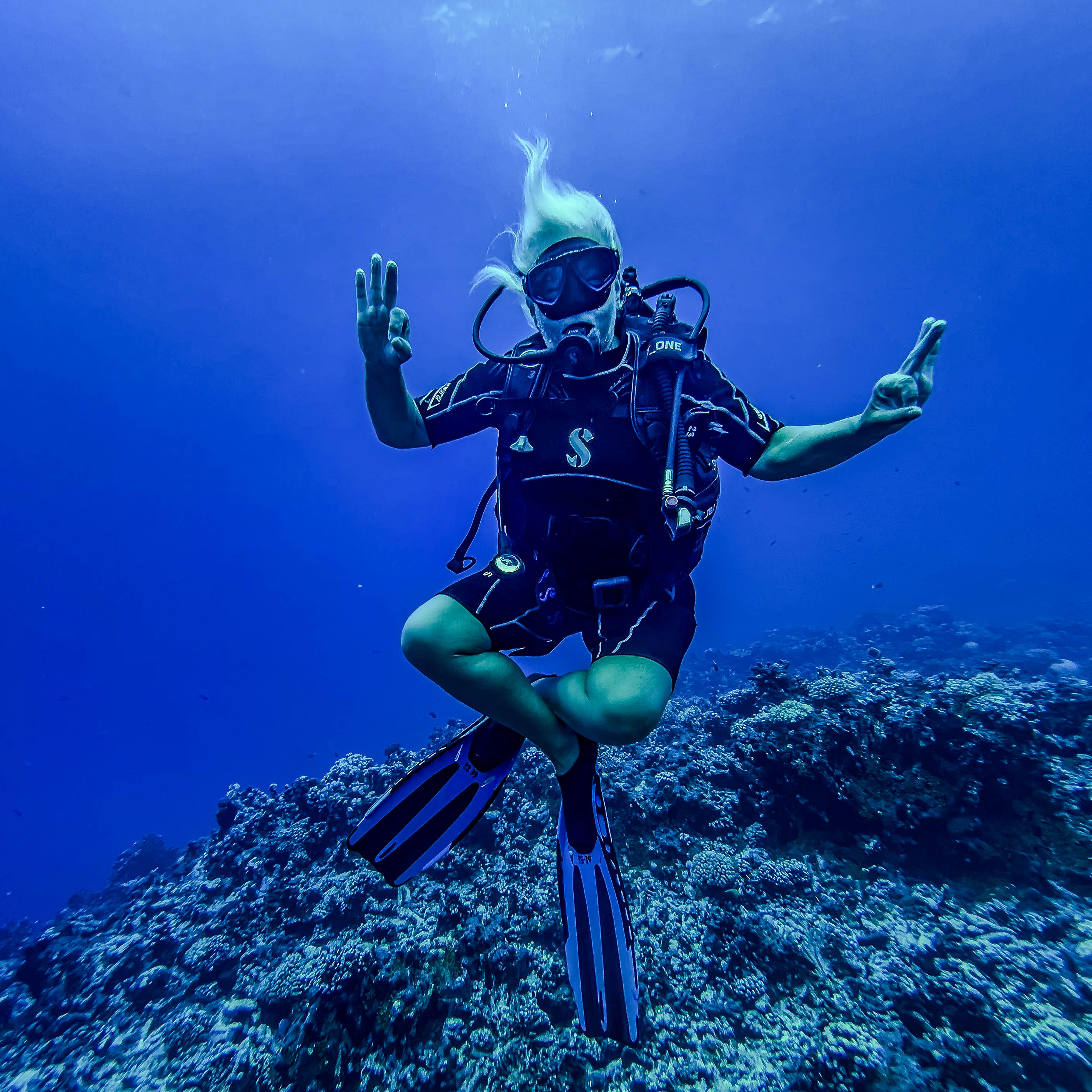
DIVING THE BLUE
Rangiroa is famous for its diving, and rightly so. We dive with Y AKA Plongée, a small, friendly operation run by Stéphane and his crew. Fluent in both French and English, they’re skilled, calm, and professional—the kind of divemasters you trust immediately. Jane earned her PADI certification with them, and we’ve done many dives together since.
Tiputa Pass and the Outer Reef
There are two main sites here. The Aquarium, just off Motu Nuhi Nuhi, is shallow and perfect for snorkeling, beginners, or discovery dives. It’s a bright, easy place where new divers find their comfort and confidence. The rest of the action happens outside on the reef, where the real personality of Rangiroa’s diving comes alive.
Most of our dives start just east of Tiputa Pass, where we drop in over the reef and drift toward the channel. On an incoming tide, the current pulls water from the open Pacific into the lagoon, carrying an extraordinary mix of life with it. We usually stay near the reef—zigzagging in and out of the blue—because most divers here are certified to the PADI Open Water limit of eighteen meters. Every so often we venture deeper, but the best of Rangiroa is right there along the reef face.
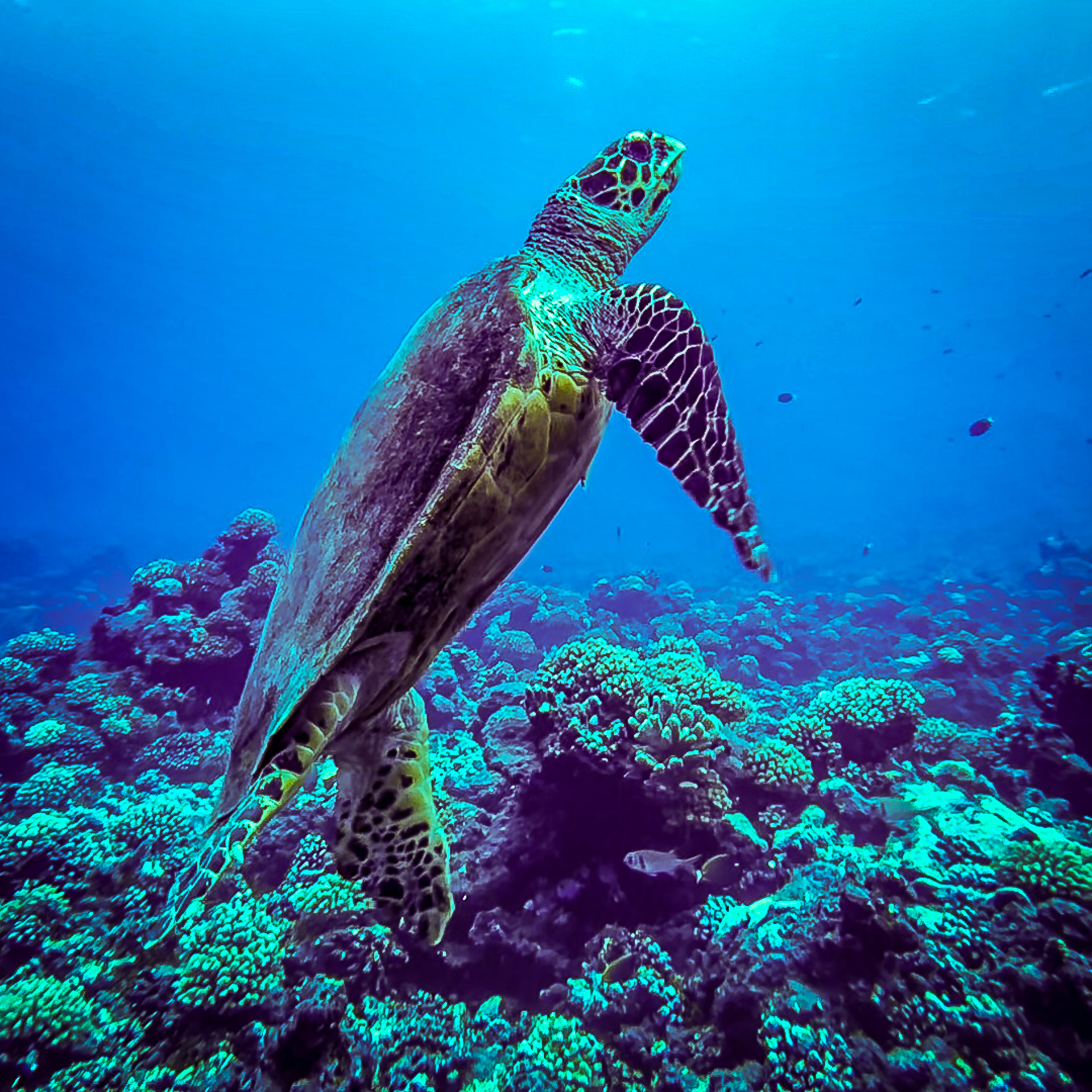
The outer reef is striking for its scale and abundance. Hard corals dominate—staghorn, brain, and plate formations—while soft corals and sponges are rare to nonexistent. Like many reefs, it shows signs of pressure, yet life still thrives here. Tropical reef fish are everywhere: schools of snapper, butterflyfish, and surgeonfish flow across the current like living rivers. Groupers hide in the crevices, and barracuda hang motionless in the blue, waiting for their chance. Moray eels peer from the coral—one of them the largest I’ve ever seen, twice the thickness of my arm and completely unfazed by our bubbles. Turtles drift past, unhurried. Sharks—gray reef, blacktip, and the occasional hammerhead—cruise the edge, their movements precise and effortless. On some dives a manta ray sweeps through, wings carving light, and on many days a pod of dolphins appears, close enough to meet your gaze. Now and then, even a whale passes offshore, a reminder that here we are part of the open Pacific itself.
Diving Life and Routine in Rangiroa
Diving in French Polynesia has its own rhythm. Most shops, including Y AKA, run single-tank dives rather than the two-tank format common in the Caribbean or U.S. The passes are close, and the RIBs they use don’t carry extra cylinders. The schedule typically runs 8:00 a.m., 10:00 a.m., 2:00 p.m., and sometimes 4:00 p.m. Between dives, everyone returns to the shop for a surface interval—time to rinse gear, swap stories, and sip strong French coffee before heading back out. We usually dive once or twice a day, favoring the mid-morning and early afternoon when the sun is high and the light on the reef is electric.
Visibility in Rangiroa is remarkable—sixty feet on an average day, often a hundred or more. The currents keep the water clear and the ecosystem alive, linking the open ocean and lagoon in a constant exchange. Every dive feels different. You surface with that mix of calm and awe that only a few places in the world can offer, reminded again why Rangiroa ranks among the best dive destinations anywhere in the South Pacific.
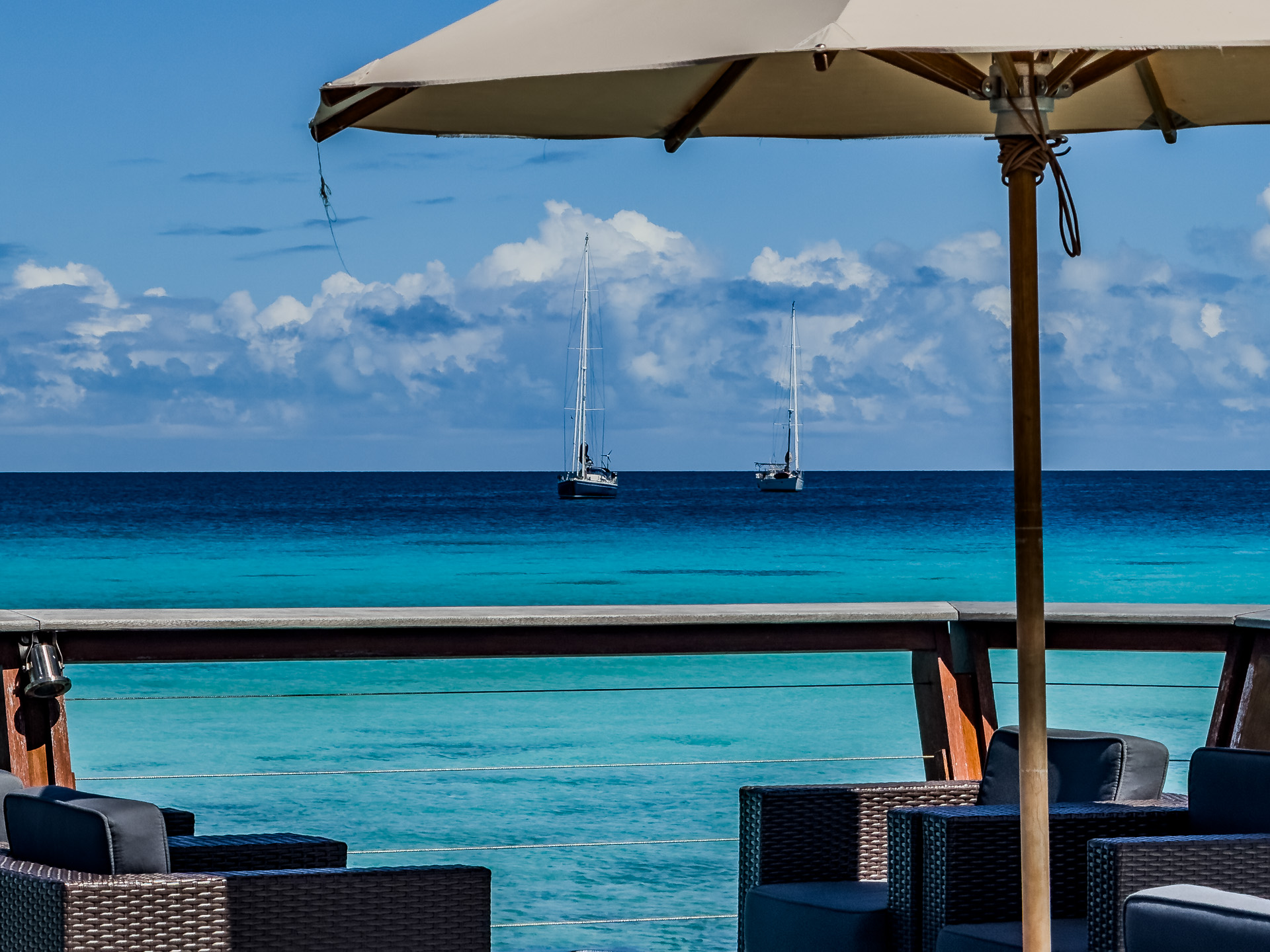
KIA ORA, THE WINERY, AND THE PEARL FARM
Our favorite anchorage is off the Kia Ora Resort, which we often use as our jumping-off point for shore excursions. Cruisers are welcome to use one side of the pier and dinghy dock, and we try to return the courtesy by stopping in for a drink or meal. The alcohol-free Coco-Mango, a blend of mango, coconut ice cream, and ice, is our favorite—cold, sweet, and perfect after a long walk in the heat. From the bar’s terrace, we can see Wanderlust anchored a little farther out, resting in a patch of teal and blue water. It’s a simple view, but it captures exactly why we’re here.
Polynesian BBQ and Traditional Dance
On Wednesday and Sunday evenings, Kia Ora hosts a Polynesian evening and barbecue that feels more like a community gathering than a resort event. Locals from the village perform the traditional dances of Rangiroa—distinct from those of Tahiti or the Marquesas—with rhythms and movements unique to this atoll. Older dancers lead, and younger ones follow, learning the steps and gestures that carry generations of meaning. You can sense that this isn’t a show put on for visitors but a way of keeping culture alive and sharing it with us. The music rises from the terrace between the restaurant and the pool, carried by the beat of the drums and the voices of the dancers. The restaurant’s wide doors stay open, so there’s nothing between the tables and the performance—just rhythm, movement, and the warmth of the night air. The dancers move beneath the stars while we sit a few steps away, plates of grilled fish and pork on the table, feeling that rare sense of being welcomed into something real.
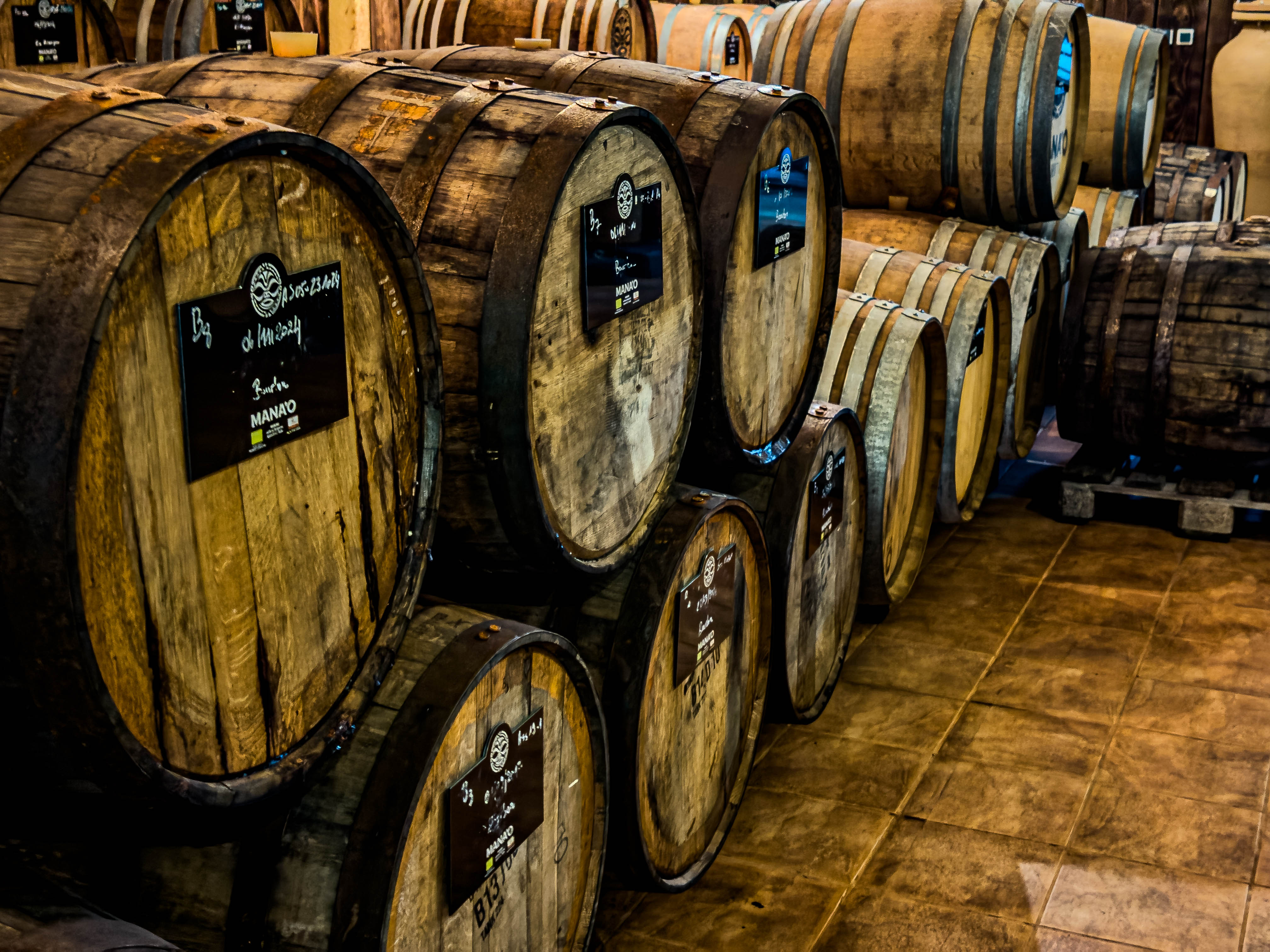
Vin de Tahiti Winery: A unique coral terroir on the atoll of Rangiroa
A few miles east lies one of Rangiroa’s most unexpected enterprises: a winery. Vin de Tahiti is the only vineyard in the world growing grapes on a coral atoll, planted on a small motu inside the lagoon more than two decades ago. The vines, rooted directly in crushed coral and sea-washed soil, are tended year-round, producing two harvests each year under the constant tropical sun. Once picked, the grapes are ferried by boat across the lagoon to the winemaking facility.
The wines—mostly white and rosé—are light and aromatic, with subtle notes of tropical fruit and a faint mineral edge from the coral soil. It’s an improbable achievement, proof that patience and persistence can coax something refined from an environment that seems anything but. The same winery also produces a smooth Rangiroa rum, distilled from locally grown sugarcane.
While at the winery, we purchased a few jars of "Le Miel de Rangiroa", a deep, amber honey produced locally since 1998.
Each product feels tied to place—not just in flavor but in spirit—an expression of the island’s creativity and resilience.
Gauguin's Pearl Farm
Closer to the anchorage, the pearl farm offers another glimpse of local craft. Oysters hang in neat rows beneath the lagoon’s surface, nurtured by the steady current and clear water. Inside the small shop, trays of black pearls shimmer in shades of green, blue, and bronze, each one slightly different from the next. Jane chose one—a single pearl set in silver, simple and elegant. It wasn’t a souvenir so much as a token of connection, a reminder that beauty here is earned slowly, by hand, in rhythm with the sea.
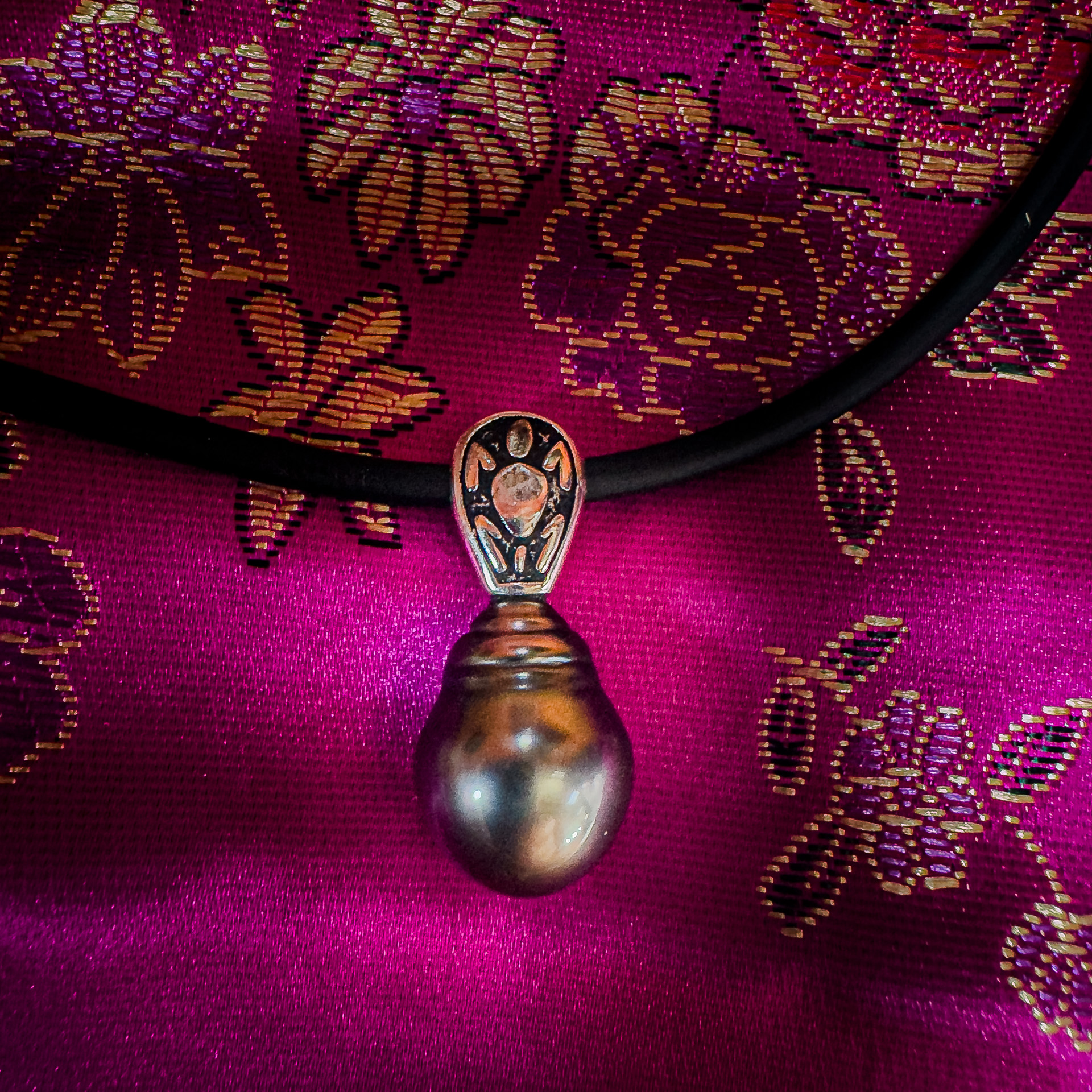
For all its remoteness, Rangiroa thrives on small acts of imagination—people finding ways to live, create, and celebrate in a place that offers little more than sand, salt, and time. The dancers, the winemakers, the pearl divers—they’re all part of the same story, one that shows how life here adapts not by resisting isolation, but by embracing it.
A STAGING POINT FOR FURTHER VOYAGES
Rangiroa also serves as a practical base for exploring the Tuamotus. We’ve used it to provision and rest before sailing on to more remote atolls like Kauehi and Tahanea. Fakarava, larger and better known, lies to the southeast, but we prefer Rangiroa’s broader anchorage and quieter feel.
Fuel and water can be arranged at the commercial wharf, though we’ve never needed the service thanks to Wanderlust’s generous tankage and watermaker.
For connectivity, Starlink keeps us online from the anchorage with steady, high-speed internet—enough for weather downloads, Wi-Fi calling, and staying in touch with family. The standard Global Roam plan works fine here, so we don’t need to enable Ocean Data, which means streaming, cloud backups, and even remote work are all possible directly from the boat. When we go ashore every few days, our AT&T international plan picks up seamlessly for local coverage. For long-range cruisers who value both remoteness and reliable communication, Rangiroa strikes that rare balance.
WHY WE STAY
In places like this, the days blend together—not in monotony, but in peace. You begin to mark time by tides, clouds, and light rather than calendars. The simplest tasks—buying bread, rinsing dive gear, chatting with locals—take on meaning.
We’ve learned that voyaging isn’t about how many miles you sail; it’s about how deeply you experience the places you reach. Some anchorages are meant for a night. Others ask for more. Rangiroa asks you to stay.
As evening falls, the trade wind hums through the rigging and the air cools with the scent of salt. Sunsets spread across the lagoon in streaks of copper and rose, and by dawn the eastern horizon glows with a soft, impossible light. Moonrises here feel close enough to touch, and on clear nights the Milky Way stretches unbroken from reef to reef. From shore, you sometimes hear a guitar or a few bars of song carried over the water, a reminder that life continues quietly beyond the anchorage. Wanderlust drifts in her own slow circle, perfectly content.
We came here thinking it would be another stop on our route through the Tuamotus. But it’s become something more—a reminder of why we sail at all. Out here, surrounded by ocean and sky, we’ve found that the greatest voyage isn’t always the one that carries you farther, but the one that teaches you to stop, look around, and realize you’ve already arrived.
